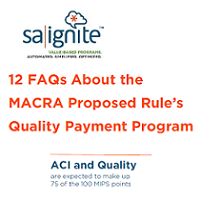 On April 27, CMS released a notice of proposed rulemaking (NPRM) for the Medicare Access and CHIP Reauthorization Act of 2015 (MACRA). Supported by a bipartisan majority and stakeholders, such as patient and medical associations, the MACRA legislation ended more than a decade of last-minute fixes and potential payment cliffs for Medicare doctors and clinicians. It also made numerous improvements to America’s health care system. Here are the facts from CMS.
On April 27, CMS released a notice of proposed rulemaking (NPRM) for the Medicare Access and CHIP Reauthorization Act of 2015 (MACRA). Supported by a bipartisan majority and stakeholders, such as patient and medical associations, the MACRA legislation ended more than a decade of last-minute fixes and potential payment cliffs for Medicare doctors and clinicians. It also made numerous improvements to America’s health care system. Here are the facts from CMS.
Download our newest white paper from SA Ignite with 12 frequently asked questions about the proposed rule.
FAQ #1 – What is MIPS?
MACRA combines the existing Medicare Meaningful Use (MU), Physician Quality Reporting System (PQRS), and Value-Based Modifier (VBM) programs into MIPS starting with the CY2017 performance year. MIPS payment adjustments are applied to Part B payments two years after the performance year, with CY2019 as the payment adjustment year for the CY2017 performance year.
MIPS defines four categories of eligible clinician performance contributing to a MIPS composite performance score (CPS) of up to 100 points (relative weights are indicated for the CY2017 performance year and associated CY2019 payment year):
- Quality (50%)
- Advancing Care Information (ACI, renamed from Meaningful Use) (25%)
- Clinical Practice Improvement Activities (CPIA) (15%)
- Resource Use (10%)
The relative weightings between the Quality and Resource Use categories change in subsequent years of the program. In addition, under certain allowable circumstances where clinician performance is unable to be determined for a given category, then MIPS sets that category’s weight to 0% and redistributes the weight to other categories. At least two categories must be rated for performance in order for the clinician to receive a CPS. If the CPS cannot be determined, then the clinician receives zero payment adjustment. MIPS clinicians can usually choose to be rated on either an individual-clinician basis or as a group of clinicians (defined by a
tax ID), with the constraint that the choice then applies across all performance categories. Certain MIPS clinicians who also participate in alternative payment models (APMs) (including clinicians not meeting qualifying participation minimums in Advanced APMs) must be rated as a group of clinicians.
Each performance category is scored separately as a percentage of maximum possible performance within that category. For example, the ACI category defines 131 ACI performance points that can be earned. Earning ACI points of 100 or more equates to 100% ACI performance, thereby contributing 100% x (ACI category weight of 25%) x 100 = 25 points towards the CPS. If fewer than 100 ACI points are earned, then ACI performance decreases proportionally such that 50 ACI points equates to 50% ACI performance, resulting in 50% x 25% x 100 = 12.5 points towards the CPS.
The performance categories contain performance-rate measures, often rated against peer benchmarks, and/or yes/no-type measures. Many measures are borrowed from the existing MU, PQRS and VBM programs. The new Clinical Practice Improvement Activities (CPIA) category includes activities such as whether same-day appointments have been enabled and many others which clinicians may choose.
The CPS is used to determine Part B payment adjustments based on a largely linear scale where almost every CPS point translates directly into payment impacts, as quantified and further explored below. Under MIPS, clinicians scoring above an annually set performance threshold will earn incentives. Those incentives are funded by penalties incurred by those scoring below the
performance threshold, keeping the overall MIPS program globally budget-neutral from a Medicare perspective. And, since many MIPS performance measures are benchmarked against peers, there is effectively a limited number of CPS points to go around, which amplifies the level of competition among clinicians to maximize their scores.
Download to read all the FAQs and the answers.
Countdown to Comments Deadline
[countdown date=”27 June 2016 17:00:00″ animation=”left-to-right”]
